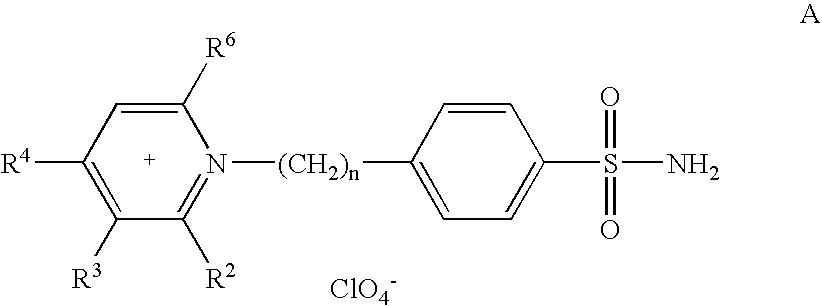CA IX-specific inhibitors
a technology of ix-specific inhibitors and lysine, which is applied in the field of genetics, can solve problems such as reducing therapy success, and achieve the effects of reducing therapy success, increasing aggressiveness of tumor cells, and reducing medium acidification
- Summary
- Abstract
- Description
- Claims
- Application Information
AI Technical Summary
Benefits of technology
Problems solved by technology
Method used
Image
Examples
example 1
Inhibition of the Tumor-Associated Isozyme IX with Aromatic and Heterocyclic Sulfonamides
[0428] The inhibition of the tumor-associated transmembrane carbonic anhydrase IX (CA IX) isozyme has been investigated with a series of aromatic and heterocyclic sulfonamides, including the six clinically used derivatives acetazolamide, methazolamide, ethoxzolamide, dichlorophenamide, dorzolamide and brinzolamide. Inhibition data for the physiologically relevant isozymes 1 and II (cytosolic forms) and IV (membrane-bound) were also provided for comparison.
[0429] Chemistry. Sulfonamides investigated for the inhibition of the tumor-associated isozyme CA IX, of types 1-26 are shown in FIG. 4A-B. Compounds 1-6, 11-12, 20 and 26 are commercially available, whereas 7-10 [43], 13-19 [24, 79, 90, 97] and 21-25 [79] were prepared as reported earlier. The six clinically used compounds were also assayed, since no such data are available in the literature.
[0430] CA inhibition data. Inhibition data agains...
example 2
The First Selective, Membrane-Impermeant Inhibitors Targeting the Tumor-Associated Isozyme IX
[0432] Up to now no CA IX inhibition studies with this type of membrane-impermeant CAIs have been reported. Thus, we decided to explore some of the pyridinium derivatives of general formula (A) for their interaction with the catalytic domain of tumor-associated isozyme IX, recently cloned and purified by the inventors [33, 43, 114, 115, 117], as well as the cytosolic, physiologically relevant isozymes CA I, II and the membrane-anchored isozyme CA IV [88, 96].
[0433] The inhibition of the tumor-associated transmembrane carbonic anhydrase IX (CA IX) isozyme has been investigated with a series of positively-charged, pyridinium derivatives of sulfanilamide, homosulfanilamide and 4-aminoethyl-benzenesulfonamide. Inhibition data for the physiologically relevant isozymes I and II (cytosolic forms) and IV (membrane-bound) were also provided for comparison. This is the first report of inhibitors tha...
example 3
Design of Selective, Membrane-Impermeant Heterocyclic Sulphonamide Inhibitors Targeting the Human Tumor-Associated Isozyme IX
[0436] A series of positively-charged sulfonamides were obtained by reaction of aminobenzolamide (5-(4-aminobenzenesulfonylamino)-1,3,4-thiadiazole-2-sulfonamide) with tri- / tetra-substituted pyrilium salts possessing alkyl-, aryl- or combinations of alkyl and aryl groups at the pyridinium ring. These new compounds are membrane-impermeant due to their salt-like character and were assayed for the inhibition of four physiologically relevant carbonic anhydrase (CA, EC 4.2.1.1) isozymes, the cytosolic hCA I and II, the membrane-anchored bCA IV and the membrane-bound, tumor associated isozyme hCA IX. The high affinity of these new derivatives for the tumor-associated isozyme CA IX and their membrane impermeability, make this type of CA inhibitors interesting candidates for the selective inhibition of only the tumor associated isozyme and not the cytosolic ones, for...
PUM
| Property | Measurement | Unit |
|---|---|---|
| Molar density | aaaaa | aaaaa |
| Molar density | aaaaa | aaaaa |
| Molar density | aaaaa | aaaaa |
Abstract
Description
Claims
Application Information
 Login to View More
Login to View More - R&D
- Intellectual Property
- Life Sciences
- Materials
- Tech Scout
- Unparalleled Data Quality
- Higher Quality Content
- 60% Fewer Hallucinations
Browse by: Latest US Patents, China's latest patents, Technical Efficacy Thesaurus, Application Domain, Technology Topic, Popular Technical Reports.
© 2025 PatSnap. All rights reserved.Legal|Privacy policy|Modern Slavery Act Transparency Statement|Sitemap|About US| Contact US: help@patsnap.com



